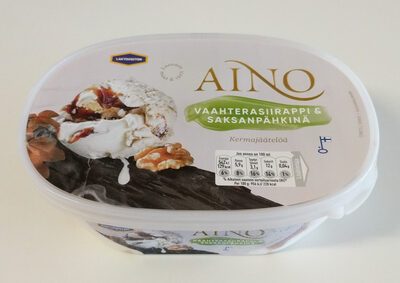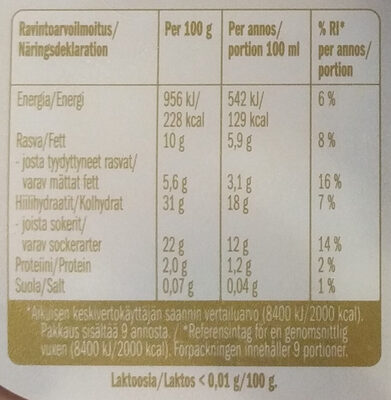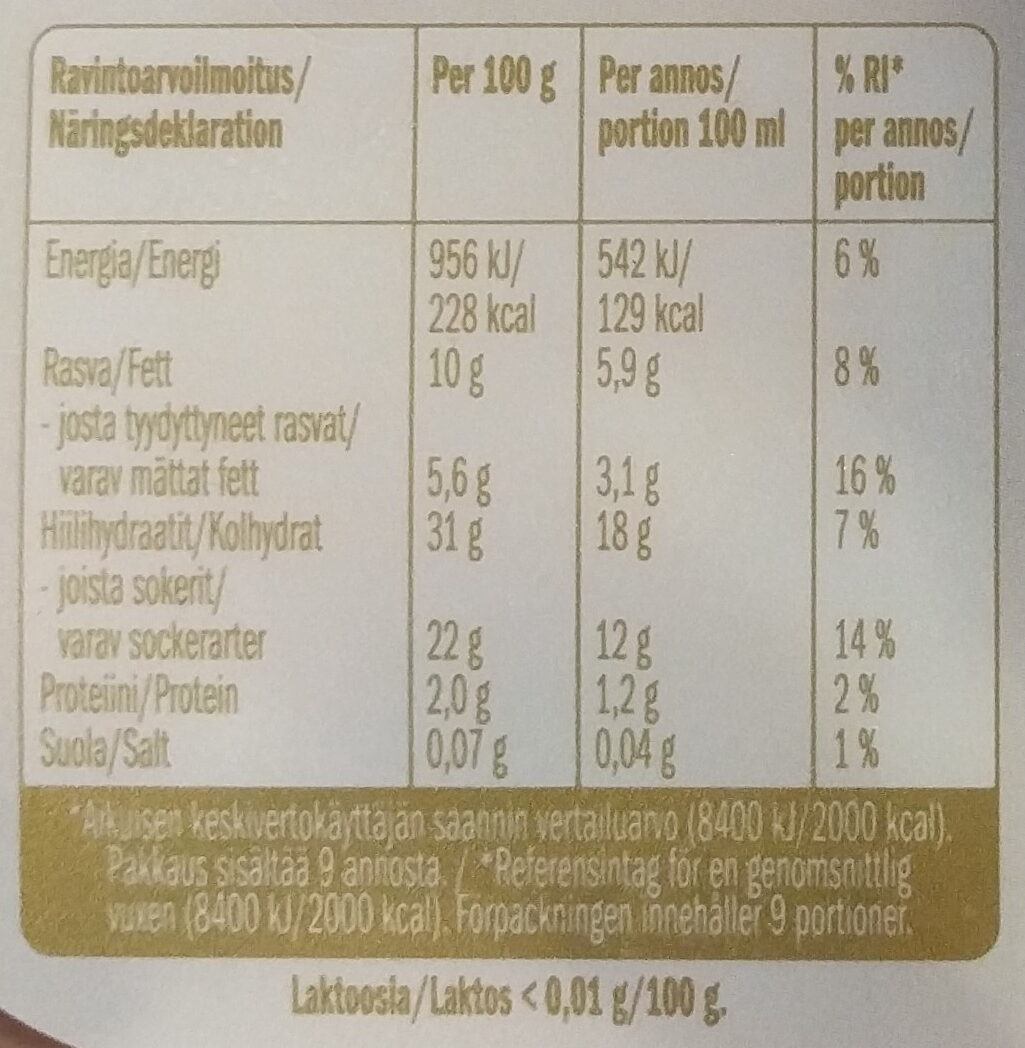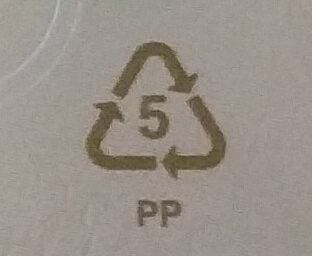Help us make food transparency the norm!
As a non-profit organization, we depend on your donations to continue informing consumers around the world about what they eat.
The food revolution starts with you!
Aino vaahterasiirappi & saksanpähkinä - 510 g / 900 ml
Aino vaahterasiirappi & saksanpähkinä - 510 g / 900 ml
Streckkod: 6430064401866 (EAN / EAN-13)
Vanligt namn: Kermajäätelö
Kvantitet: 510 g / 900 ml
Förpackning: Plast, en:pp-polypropylene
Varumärken: Aino
Kategorier: Efterrätter, Fryst mat, Frysta efterrätter, Glass och sorbet, Glass, en:Ice cream in a box
Etiketter, certifieringar, utmärkelser:
en:Avainlippu, Laktosfri
Ingredients ursprung: Europeiska unionen, Finland
Tillverknings eller bearbetningsplats: Koulutie 3, Turenki, Suomi
Länk till produktsidan på producentens officiella webbplats: https://www.pingviini.fi/tuotteet/
Butiker: K-Supermarket
Länder där såld: Finland
Matching with your preferences
Hälsa
Ingredienser
-
24 ingredienser
Skummjölk (Finland), grädde (Finland), glukossirap, socker, valnöt (0,7 %; EU och icke-EU), lönnsirap (0,5%; EU och icke-EU), emulgeringsmedel (mono - och diglycerider av fettsyror), stabiliseringsmedel (fruktkärnmjöl, guarkärnmjöl), naturlig vaniljarom och andra naturliga aromer, fortjockningsmedel (pektin), färgämnen (sockerkulör, betakaroten), malen vaniljstäng, ytbehandlingsmeděl (gummi arabicum), stärkelse (majs), maltodextrin, dekstros, solrosolja. Kan innehålla andra nötter.Allergener: Mjölk, NötterSpår: Nötter
Food processing
-
Ultra processed foods
Elements that indicate the product is in the 4 - Ultra bearbetade livsmedel och drycker group:
- Tillsats: E150a - Sockerkulör
- Tillsats: E160a - Karoten
- Tillsats: E412 - Guarkärnmjöl
- Tillsats: E414 - Gummi arabicum
- Tillsats: E440 - Pektiner
- Tillsats: E471 - Mono- och diglycerider av fettsyror
- Ingrediens: Färg
- Ingrediens: Dextros
- Ingrediens: Emulgeringsmedel
- Ingrediens: Arom
- Ingrediens: Ytbehandlingsmedel
- Ingrediens: Glukos
- Ingrediens: Glukossirap
- Ingrediens: Förtjockningsmedel
Food products are classified into 4 groups according to their degree of processing:
- Obearbetade eller minimalt bearbetade livsmedel
- Bearbetade kulinariska ingredienser
- Halvfabrikat
- Ultra processed foods
The determination of the group is based on the category of the product and on the ingredients it contains.
Tillsatser
-
E160a - Karoten
Carotene: The term carotene -also carotin, from the Latin carota, "carrot"- is used for many related unsaturated hydrocarbon substances having the formula C40Hx, which are synthesized by plants but in general cannot be made by animals -with the exception of some aphids and spider mites which acquired the synthesizing genes from fungi-. Carotenes are photosynthetic pigments important for photosynthesis. Carotenes contain no oxygen atoms. They absorb ultraviolet, violet, and blue light and scatter orange or red light, and -in low concentrations- yellow light. Carotenes are responsible for the orange colour of the carrot, for which this class of chemicals is named, and for the colours of many other fruits, vegetables and fungi -for example, sweet potatoes, chanterelle and orange cantaloupe melon-. Carotenes are also responsible for the orange -but not all of the yellow- colours in dry foliage. They also -in lower concentrations- impart the yellow coloration to milk-fat and butter. Omnivorous animal species which are relatively poor converters of coloured dietary carotenoids to colourless retinoids have yellowed-coloured body fat, as a result of the carotenoid retention from the vegetable portion of their diet. The typical yellow-coloured fat of humans and chickens is a result of fat storage of carotenes from their diets. Carotenes contribute to photosynthesis by transmitting the light energy they absorb to chlorophyll. They also protect plant tissues by helping to absorb the energy from singlet oxygen, an excited form of the oxygen molecule O2 which is formed during photosynthesis. β-Carotene is composed of two retinyl groups, and is broken down in the mucosa of the human small intestine by β-carotene 15‚15'-monooxygenase to retinal, a form of vitamin A. β-Carotene can be stored in the liver and body fat and converted to retinal as needed, thus making it a form of vitamin A for humans and some other mammals. The carotenes α-carotene and γ-carotene, due to their single retinyl group -β-ionone ring-, also have some vitamin A activity -though less than β-carotene-, as does the xanthophyll carotenoid β-cryptoxanthin. All other carotenoids, including lycopene, have no beta-ring and thus no vitamin A activity -although they may have antioxidant activity and thus biological activity in other ways-. Animal species differ greatly in their ability to convert retinyl -beta-ionone- containing carotenoids to retinals. Carnivores in general are poor converters of dietary ionone-containing carotenoids. Pure carnivores such as ferrets lack β-carotene 15‚15'-monooxygenase and cannot convert any carotenoids to retinals at all -resulting in carotenes not being a form of vitamin A for this species-; while cats can convert a trace of β-carotene to retinol, although the amount is totally insufficient for meeting their daily retinol needs.Källa: Wikipedia (Engelska)
-
E160ai - Betakaroten
Beta-Carotene: β-Carotene is an organic, strongly colored red-orange pigment abundant in plants and fruits. It is a member of the carotenes, which are terpenoids -isoprenoids-, synthesized biochemically from eight isoprene units and thus having 40 carbons. Among the carotenes, β-carotene is distinguished by having beta-rings at both ends of the molecule. β-Carotene is biosynthesized from geranylgeranyl pyrophosphate.β-Carotene is the most common form of carotene in plants. When used as a food coloring, it has the E number E160a. The structure was deduced by Karrer et al. in 1930. In nature, β-carotene is a precursor -inactive form- to vitamin A via the action of beta-carotene 15‚15'-monooxygenase.Isolation of β-carotene from fruits abundant in carotenoids is commonly done using column chromatography. It can also be extracted from the beta-carotene rich algae, Dunaliella salina. The separation of β-carotene from the mixture of other carotenoids is based on the polarity of a compound. β-Carotene is a non-polar compound, so it is separated with a non-polar solvent such as hexane. Being highly conjugated, it is deeply colored, and as a hydrocarbon lacking functional groups, it is very lipophilic.Källa: Wikipedia (Engelska)
-
E412 - Guarkärnmjöl
Guar gum: Guar gum, also called guaran, is a galactomannan polysaccharide extracted from guar beans that has thickening and stabilizing properties useful in the food, feed and industrial applications. The guar seeds are mechanically dehusked, hydrated, milled and screened according to application. It is typically produced as a free-flowing, off-white powder.Källa: Wikipedia (Engelska)
-
E414 - Gummi arabicum
Gum arabic: Gum arabic, also known as acacia gum, arabic gum, gum acacia, acacia, Senegal gum and Indian gum, and by other names, is a natural gum consisting of the hardened sap of various species of the acacia tree. Originally, gum arabic was collected from Acacia nilotica which was called the "gum arabic tree"; in the present day, gum arabic is collected from acacia species, predominantly Acacia senegal and Vachellia -Acacia- seyal; the term "gum arabic" does not indicate a particular botanical source. In a few cases so‐called "gum arabic" may not even have been collected from Acacia species, but may originate from Combretum, Albizia or some other genus. Producers harvest the gum commercially from wild trees, mostly in Sudan -80%- and throughout the Sahel, from Senegal to Somalia—though it is historically cultivated in Arabia and West Asia. Gum arabic is a complex mixture of glycoproteins and polysaccharides. It is the original source of the sugars arabinose and ribose, both of which were first discovered and isolated from it, and are named after it. Gum arabic is soluble in water. It is edible, and used primarily in the food industry as a stabilizer, with EU E number E414. Gum arabic is a key ingredient in traditional lithography and is used in printing, paint production, glue, cosmetics and various industrial applications, including viscosity control in inks and in textile industries, though less expensive materials compete with it for many of these roles. While gum arabic is now produced throughout the African Sahel, it is still harvested and used in the Middle East.Källa: Wikipedia (Engelska)
-
E440 - Pektiner
Pectin: Pectin -from Ancient Greek: πηκτικός pēktikós, "congealed, curdled"- is a structural heteropolysaccharide contained in the primary cell walls of terrestrial plants. It was first isolated and described in 1825 by Henri Braconnot. It is produced commercially as a white to light brown powder, mainly extracted from citrus fruits, and is used in food as a gelling agent, particularly in jams and jellies. It is also used in dessert fillings, medicines, sweets, as a stabilizer in fruit juices and milk drinks, and as a source of dietary fiber.Källa: Wikipedia (Engelska)
-
E471 - Mono- och diglycerider av fettsyror
Mono- and diglycerides of fatty acids: Mono- and diglycerides of fatty acids -E471- refers to a food additive composed of diglycerides and monoglycerides which is used as an emulsifier. This mixture is also sometimes referred to as partial glycerides.Källa: Wikipedia (Engelska)
Ingrediensanalys
-
Kan innehålla palmolja
Ingredienser som kan innehålla palmolja: E471, E160ai
-
Icke-vegan
Non-vegan ingredients: Mjölk, GräddeVissa ingredienser kunde inte kännas igen.
Vi behöver din hjälp!
You can help us recognize more ingredients and better analyze the list of ingredients for this product and others:
- Edit this product page to correct spelling mistakes in the ingredients list, and/or to remove ingredients in other languages and sentences that are not related to the ingredients.
- Add new entries, synonyms or translations to our multilingual lists of ingredients, ingredient processing methods, and labels.
If you would like to help, join the #ingredients channel on our Slack discussion space and/or learn about ingredients analysis on our wiki. Thank you!
-
Vegetarisk status okänd
Okända ingredienser: fi:muu-kuin-euVissa ingredienser kunde inte kännas igen.
Vi behöver din hjälp!
You can help us recognize more ingredients and better analyze the list of ingredients for this product and others:
- Edit this product page to correct spelling mistakes in the ingredients list, and/or to remove ingredients in other languages and sentences that are not related to the ingredients.
- Add new entries, synonyms or translations to our multilingual lists of ingredients, ingredient processing methods, and labels.
If you would like to help, join the #ingredients channel on our Slack discussion space and/or learn about ingredients analysis on our wiki. Thank you!
-
Details of the analysis of the ingredients
Vi behöver din hjälp!
Vissa ingredienser kunde inte kännas igen.
Vi behöver din hjälp!
You can help us recognize more ingredients and better analyze the list of ingredients for this product and others:
- Edit this product page to correct spelling mistakes in the ingredients list, and/or to remove ingredients in other languages and sentences that are not related to the ingredients.
- Add new entries, synonyms or translations to our multilingual lists of ingredients, ingredient processing methods, and labels.
If you would like to help, join the #ingredients channel on our Slack discussion space and/or learn about ingredients analysis on our wiki. Thank you!
: _Maito_, _kerma_, glukoosisiirappi, sokeri, _saksanpähkinä_ 0.7%, vaahterasiirappi 0.5% (muu kuin EU), emulgointiaine (rasvahappojen mono- ja diglyseridit), stabilointiaineet (johanneksenleipäpuujauhe, guarkumi), luontainen vanilja-aromi ja muita luontaisia aromeja, sakeuttamisaine (pektiini), värit (sokerikulööri, betakaroteeni), vaniljatanko, pintakäsittelyaine (arabikumi), tärkkelys (maissi), dekstroosi- _Maito_ -> en:milk - vegan: no - vegetarian: yes - ciqual_proxy_food_code: 19051 - percent_min: 6.66666666666667 - percent_max: 96.7
- _kerma_ -> en:cream - vegan: no - vegetarian: yes - ciqual_food_code: 19402 - percent_min: 0.7 - percent_max: 48.7
- glukoosisiirappi -> en:glucose-syrup - vegan: yes - vegetarian: yes - ciqual_proxy_food_code: 31016 - percent_min: 0.7 - percent_max: 32.7
- sokeri -> en:sugar - vegan: yes - vegetarian: yes - ciqual_proxy_food_code: 31016 - percent_min: 0.7 - percent_max: 22
- _saksanpähkinä_ -> en:walnut - vegan: yes - vegetarian: yes - ciqual_food_code: 15023 - percent_min: 0.7 - percent: 0.7 - percent_max: 0.7
- vaahterasiirappi -> en:maple-syrup - vegan: yes - vegetarian: yes - percent_min: 0.5 - percent: 0.5 - percent_max: 0.5
- muu kuin EU -> fi:muu-kuin-eu - percent_min: 0.5 - percent_max: 0.5
- emulgointiaine -> en:emulsifier - percent_min: 0 - percent_max: 0.5
- rasvahappojen mono- ja diglyseridit -> en:e471 - vegan: maybe - vegetarian: maybe - from_palm_oil: maybe - percent_min: 0 - percent_max: 0.5
- stabilointiaineet -> en:stabiliser - percent_min: 0 - percent_max: 0.5
- johanneksenleipäpuujauhe -> en:carob-seed-flour - vegan: yes - vegetarian: yes - ciqual_proxy_food_code: 9410 - percent_min: 0 - percent_max: 0.5
- guarkumi -> en:e412 - vegan: yes - vegetarian: yes - percent_min: 0 - percent_max: 0.25
- luontainen vanilja-aromi ja muita luontaisia aromeja -> en:natural-vanilla-flavouring-with-other-natural-flavourings - vegan: maybe - vegetarian: maybe - percent_min: 0 - percent_max: 0.5
- sakeuttamisaine -> en:thickener - percent_min: 0 - percent_max: 0.5
- pektiini -> en:e440a - vegan: yes - vegetarian: yes - percent_min: 0 - percent_max: 0.5
- värit -> en:colour - percent_min: 0 - percent_max: 0.5
- sokerikulööri -> en:e150a - vegan: yes - vegetarian: yes - percent_min: 0 - percent_max: 0.5
- betakaroteeni -> en:e160ai - vegan: maybe - vegetarian: maybe - from_palm_oil: maybe - percent_min: 0 - percent_max: 0.25
- vaniljatanko -> en:vanilla-pod - vegan: yes - vegetarian: yes - percent_min: 0 - percent_max: 0.5
- pintakäsittelyaine -> en:glazing-agent - percent_min: 0 - percent_max: 0.5
- arabikumi -> en:e414 - vegan: yes - vegetarian: yes - percent_min: 0 - percent_max: 0.5
- tärkkelys -> en:starch - vegan: yes - vegetarian: yes - ciqual_proxy_food_code: 9510 - percent_min: 0 - percent_max: 0.5
- maissi -> en:corn - vegan: yes - vegetarian: yes - ciqual_food_code: 9200 - percent_min: 0 - percent_max: 0.5
- dekstroosi -> en:dextrose - vegan: yes - vegetarian: yes - ciqual_proxy_food_code: 31016 - percent_min: 0 - percent_max: 0.5
Näring
-
Poor nutritional quality
⚠ ️Varning: mängden fibrer är inte angiven, eventuella positiv inverkan på betyget kunde inte beaktas.⚠ ️Warning: the amount of fruits, vegetables and nuts is not specified on the label, it was estimated from the list of ingredients: 0This product is not considered a beverage for the calculation of the Nutri-Score.
Positiva poäng: 0
- Proteiner: 1 / 5 (värde: 2, avrundat värde: 2)
- Fiber: 0 / 5 (värde: 0, avrundat värde: 0)
- Frukt, grönsaker, nötter och raps- / valnöt- / olivoljor: 0 / 5 (värde: 0.7, avrundat värde: 0.7)
Negativa poäng: 11
- Energi: 2 / 10 (värde: 956, avrundat värde: 956)
- Socker: 4 / 10 (värde: 22, avrundat värde: 22)
- Mättat fett: 5 / 10 (värde: 5.6, avrundat värde: 5.6)
- Natrium: 0 / 10 (värde: 28, avrundat värde: 28)
The points for proteins are not counted because the negative points are greater or equal to 11.
Näringsvärde: (11 - 0)
Nutri-Score:
-
Näringsvärden
-
Fett i måttlig kvantitet (10%)
What you need to know- A high consumption of fat, especially saturated fats, can raise cholesterol, which increases the risk of heart diseases.
Recommendation: Limit the consumption of fat and saturated fat- Choose products with lower fat and saturated fat content.
-
Mättat fett i hög kvantitet (5.6%)
What you need to know- A high consumption of fat, especially saturated fats, can raise cholesterol, which increases the risk of heart diseases.
Recommendation: Limit the consumption of fat and saturated fat- Choose products with lower fat and saturated fat content.
-
Sockerarter i hög kvantitet (22%)
What you need to know- A high consumption of sugar can cause weight gain and tooth decay. It also augments the risk of type 2 diabetes and cardio-vascular diseases.
Recommendation: Limit the consumption of sugar and sugary drinks- Sugary drinks (such as sodas, fruit beverages, and fruit juices and nectars) should be limited as much as possible (no more than 1 glass a day).
- Choose products with lower sugar content and reduce the consumption of products with added sugars.
-
Salt i låg kvantitet (0.07%)
What you need to know- A high consumption of salt (or sodium) can cause raised blood pressure, which can increase the risk of heart disease and stroke.
- Many people who have high blood pressure do not know it, as there are often no symptoms.
- Most people consume too much salt (on average 9 to 12 grams per day), around twice the recommended maximum level of intake.
Recommendation: Limit the consumption of salt and salted food- Reduce the quantity of salt used when cooking, and don't salt again at the table.
- Limit the consumption of salty snacks and choose products with lower salt content.
-
-
Näringsfakta
Näringsfakta Som såld
för 100 g / 100 mlSom såld
per portion (56,67 g)Compared to: Glass Energi 956 kj
(228 kcal)542 kj
(129 kcal)−6 % Fett 10 g 5,67 g −14 % Mättat fett 5,6 g 3,17 g −24 % Kolhydrat 31 g 17,6 g +2 % Sockerarter 22 g 12,5 g −1 % Laktos < 0,01 g < 0,006 g +10 % Fiber ? ? Protein 2 g 1,13 g −28 % Salt 0,07 g 0,04 g −52 % Fruits‚ vegetables‚ nuts and rapeseed‚ walnut and olive oils (estimate from ingredients list analysis) 0,7 % 0,7 %
Miljö
-
Eco-Score A - Mycket låg miljöpåverkan
The Eco-Score is an experimental score that summarizes the environmental impacts of food products.→ The Eco-Score was initially developped for France and it is being extended to other European countries. The Eco-Score formula is subject to change as it is regularly improved to make it more precise and better suited to each country.Life cycle analysis
-
Average impact of products of the same category: A (Score: 87/100)
Kategori: Ice cream, in box
Kategori: Ice cream, in box
- PEF environmental score: 0.22 (the lower the score, the lower the impact)
- including impact on climate change: 1.75 kg CO2 eq/kg of product
Stage Impact Jordbruk
56.9 %Bearbetar
18.1 %Förpackning
6.7 %Transportation
6.9 %Distribution
7.2 %Consumption
4.2 %
Bonuses and maluses
-
Origins of ingredients with a low impact
Bonus: +16
Environmental policy: +3
Transportation: +13
Origin of the product and/or its ingredients % of ingredients Impact Finland 88 %Låg Europeiska unionen 12 %Hög Unknown 0 %Hög
-
Packaging with a medium impact
Malus: -8
Form Material Återvinning Impact Okänd PP 5 - polypropen Hög ⚠ ️ The information about the packaging of this product is not sufficiently precise (exact shapes and materials of all components of the packaging).⚠ ️ For a more precise calculation of the Eco-Score, you can modify the product page and add them.
If you are the manufacturer of this product, you can send us the information with our free platform for producers.
Eco-Score for this product
-
Impact for this product: A (Score: 95/100)
Produkt: Aino vaahterasiirappi & saksanpähkinä - 510 g / 900 ml
Life cycle analysis score: 87
Sum of bonuses and maluses: +8
Final score: 95/100
-
Carbon footprint
-
Equal to driving 0.9 km in a petrol car
175 g CO² per 100g of product
The carbon emission figure comes from ADEME's Agribalyse database, for the category: Ice cream, in box (Source: ADEME Agribalyse Database)
Stage Impact Jordbruk
61.0 %Bearbetar
12.3 %Förpackning
10.3 %Transportation
11.3 %Distribution
3.7 %Consumption
1.4 %
Förpackning
-
Packaging with a medium impact
-
Packaging parts
(PP 5 - polypropen)
-
Packaging materials
Material % Packaging weight Packaging weight per 100 g of product Plast
-
Transportation
-
Origins of ingredients
Origins of ingredients with a low impact
Origin of the product and/or its ingredients % of ingredients Impact Finland 88 %Låg Europeiska unionen 12 %Hög Unknown 0 %Hög
Report a problem
-
Incomplete or incorrect information?
Category, labels, ingredients, allergens, nutritional information, photos etc.
If the information does not match the information on the packaging, please complete or correct it. Open Food Facts is a collaborative database, and every contribution is useful for all.
Datakällor
Produkt tillagd den av mvainola
Senast ändrad produktsida på av moon-rabbit.
Produktsida också redigerad av openfoodfacts-contributors.













